The Antikythera Mechanism: The Prove of the Accuracy of the Astronomical Calculations Based on It
Abstract
:1. Introduction
1.1. The Antikythera Shipwreck and the Discovery of the Mechanism
1.2. The Investigation of the Antikythera Mechanism
2. Results
2.1. Description of the Antikythera Mechanism
2.1.1. The Front Site, the 12 Zodiac Constellations and the Egyptian Calendar
The Egyptian Calendar
- the annual floods of the Nile and
- the appearance of Sirius shortly before sunrise.
The Julian Calendar
The Gregorian Calendar
2.1.2. The Back Site
2.2. The Antikythera Mechanism, from Physical to Digital 3D Representations
2.3. Importance, Purpose, Utility, Operation and Handling of the Mechanism
2.3.1. Importance and Purpose of the Mechanism
2.3.2. Utility, Operation and Handling
2.4. Place and Date of the Construction of the Antikythera Mechanism
2.5. Construction’s Materials of the Mechanism
2.6. Documentation of the Existents of the Necessary Knowledge for the Mechanism Design, Construction and Manufacturing at the Time and at the Place of Its Construction
2.6.1. Scientific and Technological Knowledge Necessary for the Design of the Mechanism
2.6.2. Technological Knowledge Necessary for the Manufacturing of the Mechanism
3. Construction of Digital 3D Representations and Reconstruction of Physical Functional Copies
4. Prediction Accuracy
4.1. Development of an Application to Calculate the Prediction’s Accuracy of the Antikythera Mechanism
4.2. Examples of the Application’s Predictions
4.2.1. 1st Example: Prediction of the Astronomical Phenomena for the 26 May 2021
4.2.2. Second Example: Prediction of the Astronomical Phenomena for 10 June 2021
4.3. Calculate the Exact Date of the Celebration of Easter
4.3.1. Predictions of the Date of the Catholic Easter of 2021
4.3.2. Predictions of the Orthodox Easter Date in 2021
4.4. Accuracy of Predictions of the Replica of the Antikythera Mechanism
- (a)
- Eclipses pointer: Σ (Σελήνη = Moon), Θ = 9 (time of the event 9 o’clock); and
- (b)
- Exeligmos Index: H = 8 h delay (must be added to Θ).
4.5. Example of Calculations That Simulate the Kinematics of the Mechanism
4.6. Accuracy of the Mechanism’s Predictions
- (a)
- the accuracy of the equinoxes;
- (b)
- the inaccuracy of the mechanism (mainly of the Saros scale) for in-depth predictions; and
- (c)
- the experience of the operator in using the Mechanism and his knowledge of the astronomical phenomena.
4.6.1. Physical Accurate Functional Models (and Original Mechanism)
Handling Steps for Accurate Prediction of Future Phenomena
- A.
- Rotate the gears until all the pointers move simultaneously. This will lead to the cooperating gears to be engaged, eliminating the gaps that occur due to the triangular shape of their teeth, or possible inaccuracies during their construction.
- B.
- Adjustment of the indicator’s position of the Mechanism, using data of a recent eclipse (within a period of about 100 years) and prediction of the future phenomenon.
- C.
- If the next forecast refers to a date later than the previous one, no further action is required by the operator.
- D.
- If the next forecast refers to a date earlier than the previous one, the Mechanism should be firstly turned backwards to a date earlier than the desired one and then forward to the desired date. By doing this, all the gaps that may occur, due to their opposite rotation, are eliminated.
Handling Steps for Accurate Prediction of Past Phenomena
4.6.2. Prediction with the Developed Application which Simulates the Mechanism
5. Conclusions
Author Contributions
Funding
Institutional Review Board Statement
Informed Consent Statement
Data Availability Statement
Acknowledgments
Conflicts of Interest
References
- Seiradakis, J.H.; Edmunds, M. Our current knowledge of the Antikythera Mechanism. Nat. Astron. 2018, 2, 35–42. [Google Scholar] [CrossRef]
- Jones, A. A portable Cosmos; Oxford University: New York, NY, USA, 2017. [Google Scholar]
- Kaltsas, N.; Vlachoyanni, H.; Bouyia, P. The Antikythera Shipwreck; National Archaeological Museum of Athens: Athens, Greece, 2012. (In Greek) [Google Scholar]
- Zafeiropoulou, M. The Antikythera Thesaurus. In Proceedings of the Oral presentation at Symi Festival, Symi, Greece, 31 August 2007. [Google Scholar]
- Archaeological Ephemeris, Issue 1 &2, 3rd Period. 1902; 145–173.
- Price de Solla, D. Gears from the Greeks: The Antikythera Mechanism—A calendar computer from ca 80 BC. Trans. Am. Phil. Soc. New Ser. 1974, 64, 1–70. [Google Scholar] [CrossRef]
- Wright, M.T. Epicyclic Gearing and the Antikythera Mechanism, part 2. Antiqu. Horol. 2005, 29, 51–63. [Google Scholar]
- Ramsey, A. The latest techniques reveal the earliest technology – A new inspection of the Antikythera Mechanism. In Proceedings of the International Symposium on Digital industrial Radiology and Computed Tomography, Lyon, France, 25–27 June 2007. [Google Scholar]
- Malzbender, T.; Gelb, D.; Wolters, H. Polynomial Texture Maps. Available online: http://www.hpl.hp.com/research/ptm/papers/ptm.pdf (accessed on 15 August 2021).
- Freeth, T.; Bitsakis, Y.; Moussas, X.; Seiradakis, J.H.; Tselikas, A.; Mangou, H.; Zafeiropoulou, M.; Hadland, R.; Bate, D.; Ramsey, A.; et al. Decoding the ancient Greek astronomical calculator known as the Antikythera Mechanism. Nature 2006, 444, 587–591. [Google Scholar] [CrossRef] [PubMed]
- Efstathiou, K.; Basiakoulis, A.; Efstathiou, M.; Anastasiou, M.; Seiradakis, J.H. Determination of the gears geometrical parameters necessary for the construction of an operational model of the Antikythera Mechanism. Mech. Mach. Theory 2012, 52, 219–231. [Google Scholar] [CrossRef]
- Efstathiou, M.; Basiakoulis, A.; Efstathiou, K.; Anastasiou, M.; Boutbaras, P.; Seiradakis, J.H.S. The Reconstruction of the Antikythera Mechanism. Int. J. Herit. Digit. Era 2013, 2, 307–334. [Google Scholar] [CrossRef] [Green Version]
- Anastasiou, M.; Seiradakis, J.; Carman, C.C.; Efstathiou, K. The Antikythera Mechanism: The structure of the mounting of the back-plate’s pointer and the construction of the spirals. J. Hist. Astron 2014, 45, 418–441. [Google Scholar] [CrossRef]
- Efstathiou, K.; Efstathiou, M.; Gearbox, C. The oldest known computer is a mechanism designed to calculate the location of the sun, moon, and planets (Cover Story) Mechanical Engineering. ASME Magazine, September 2018; 31–35. [Google Scholar]
- Anastasiou, M.; Seiradakis, J.H.; Evans, J.; Drougou, S.; Efstathiou, K. The astronomical events of the Parapegma of the Antikythera Mechanism. J. Hist. Astron. 2013, 44, 125–138. [Google Scholar] [CrossRef]
- Anastasiou, M. The Antikythera Mechanism: Astronomy and Technology in Ancient Greece. Ph.D. Thesis, Aristotle University of Thessaloniki, Thessaloniki, Greece, 2014. (In Greek). [Google Scholar]
- Efstathiou, M. The usage of innovative techniques of 3d design, 3d scanning and 3d printing in the investigation of ancient artifacts and other objects so as, among others, to construct their accurate replicas—Case Study of The Antikythera Mechanism. Ph.D. Thesis, School of Mechanical Engineering, Aristotle University of Thessaloniki, Thessaloniki, Greece, 2018. (In Greek). [Google Scholar]
- Efstathiou, M.; Skordaris, G.; Basiakoulis, A.; Efstathiou, K. Construction of accurate and operational models of the Antikythera Mechanism using various manufacturing techniques such as conventional cutting, laser cutting and 3D printing technologies. In Proceedings of the 6th International Conference on Manufacturing Engineering ICMEN, Thessaloniki, Greece, 5–6 October 2017; pp. 293–308. [Google Scholar]
- Basiakoulis, A.; Efstathiou, M.; Efstathiou, K.; Skordaris, G.; Seiradakis, J.H. The handling of the Antikythera Mechanism. In Proceedings of the 6th International Conference on Manufacturing Engineering ICMEN, Thessaloniki, Greece, 5–6 October 2017; pp. 281–292. [Google Scholar]
- Ptolemy III Euergetes. Macedonian king of Egypt. Available online: www.britannica.com/biography/Ptolemy-III-Euergetes (accessed on 15 August 2021).
- Egyptian calendar. Available online: https://en.wikipedia.org/wiki/Egyptian_calendar, (accessed on 15 August 2021).
- Star Sirius. Available online: https://en.wikipedia.org/wiki/Star_Sirius, (accessed on 15 August 2021).
- Nut (goddess). Available online: https://en.wikipedia.org/wiki/Nut_(goddess) (accessed on 15 August 2021).
- Parker, R.A. The Calendars of Ancient Egypt; The University Of Chicago Press: Chicago, IL, USA, 1950. Available online: https://oi.uchicago.edu/sites/oi.uchicago.edu/files/uploads/shared/docs/saoc26.pdf (accessed on 20 October 2021).
- Theodosiou, S.; Danezis, M. The Odyssey of Calendars; Diablos Publications: Athens, Greece, 1995. (In Greek) [Google Scholar]
- Spalinger, A. Ancient Egyptian Calendars. In Handbook of Archeoastronomy and Ethnoastronomy; Springer Science and Business Media: New York, NY, USA, 2015; p. 1489. [Google Scholar]
- Wright, M.T. Epicyclic gearing and the Antikythera Mechanism, Part I. Antiquar. Horol. 2003, 27, 270–279. [Google Scholar]
- Gourtsoyannis, E. Hipparchus vs. Ptolemy and the Antikythera Mechanism: Pin-slot device models lunar motion. J. Adv. Space Res. 2010, 46, 540–544. [Google Scholar] [CrossRef]
- Voulgaris, A.; Christophoros, M.; Andreas, V.; George, B. Renumbering of the Antikythera mechanism saros cells, resulting from the saros spiral mechanical apokatastasis. Mediterr. Archaeol. Archaeom. 2021, 21, 107–128. [Google Scholar] [CrossRef]
- Gourtsoyannis, E. Science and Culture Promise, Challege and Demand 285–289; Epikentro Publications: Thessaloniki, Greece, 2012. [Google Scholar]
- Freeth, T.; Jones, A.; Steele, J.M.; Bitsakis, Y. Calendars with Olympiad display and eclipse prediction on the Antikythera Mechanism. Nature 2008, 454, 614–617. [Google Scholar] [CrossRef] [PubMed]
- Vlachogianni, E.; Lagogianni-Georgakarakos, M.; Andrea, B.; Nikos Kaltsas, N. Der Versunkene Shatz—Das Schiffswrack von Antikythera; Andrea Bignasca: Basel, Switzerland, 2015. [Google Scholar]
- Spandagos, E. HΜαθηματική Συναγωγή του Πάππου του Aλεξανδρέως, vol Δ’; Aίθρα: Athens, Greece, 2006. (In Greek) [Google Scholar]
- Antikythera Mechanism Simulation. Available online: http://www.etl.uom.gr/mr/index.php?mypage=antikythera_sim (accessed on 20 October 2021).
- The Antikythera Mechanism. The most accurate and functional replicas of the Antikythera Mechanism ever made! Available online: https://www.antimech.com (accessed on 20 October 2021).
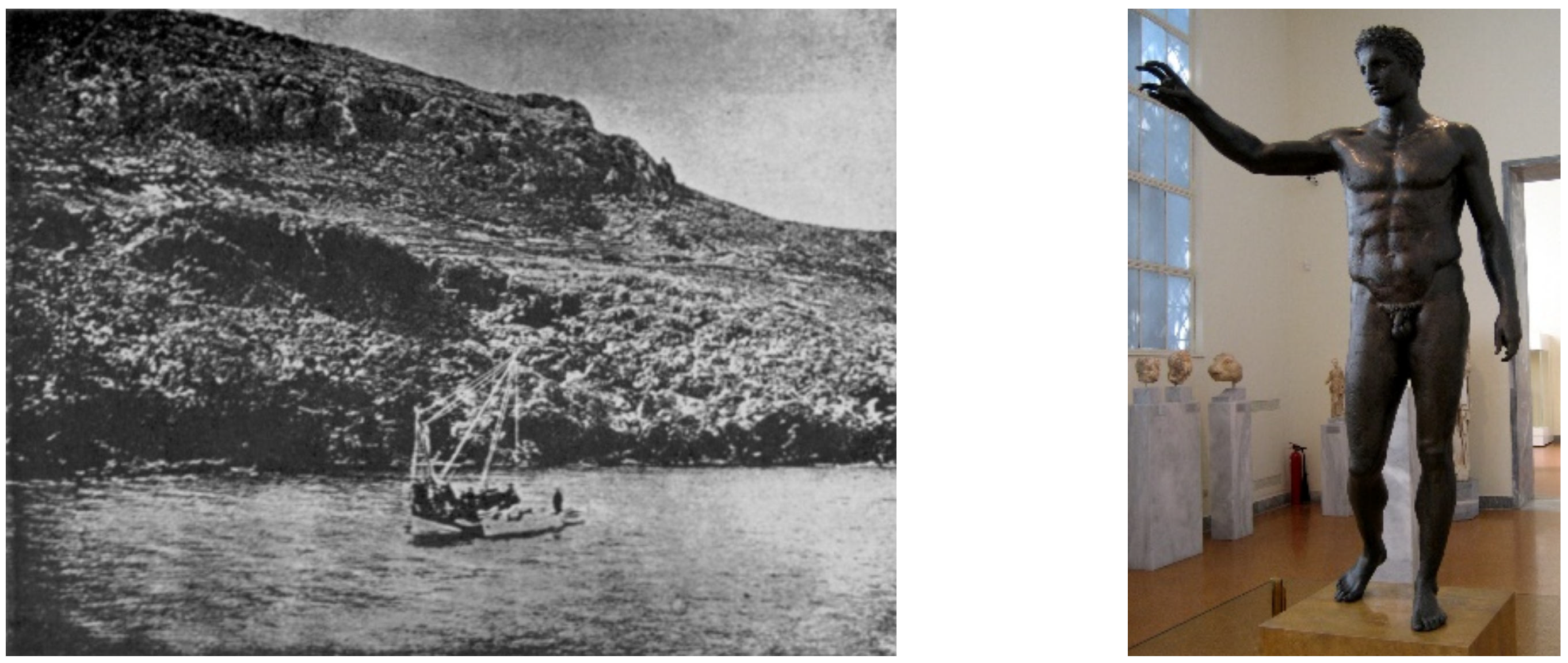








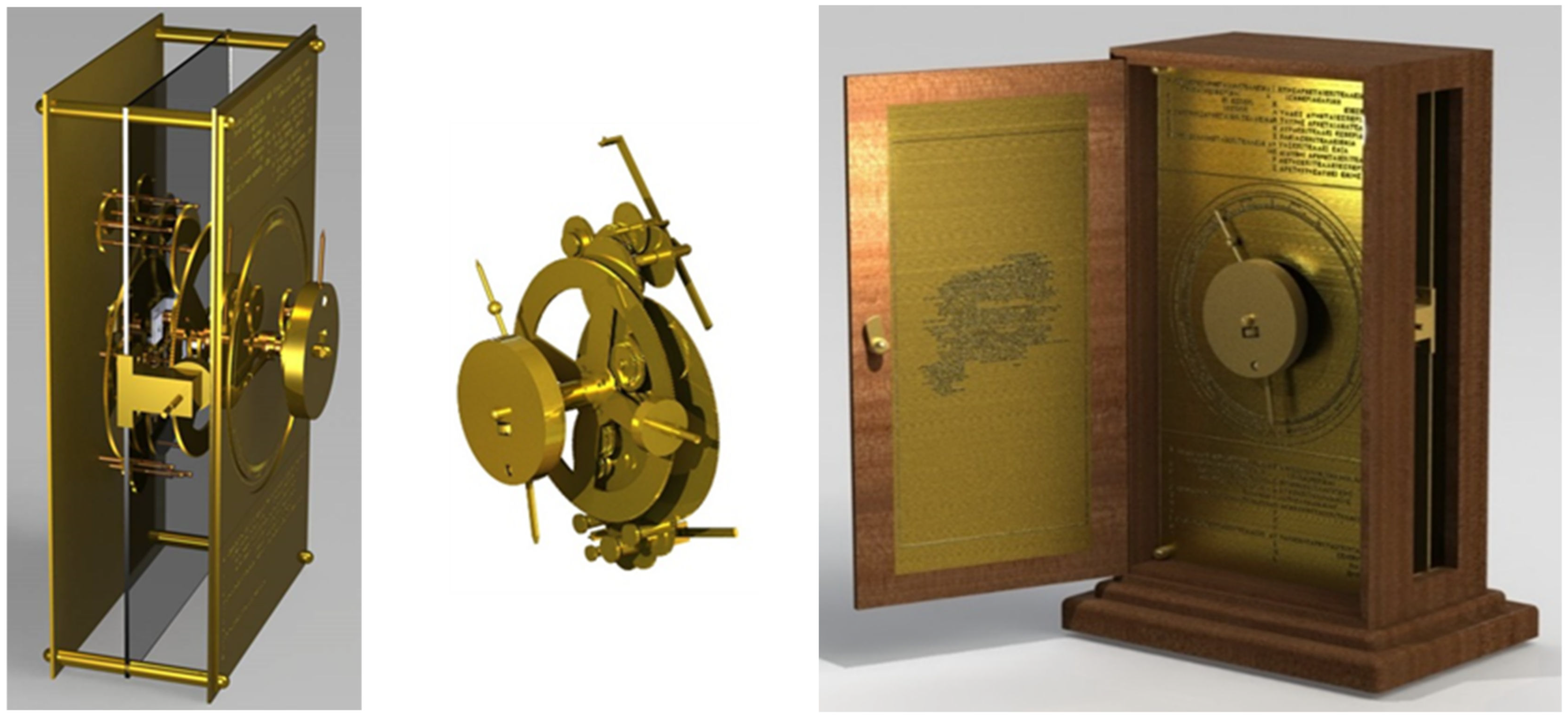




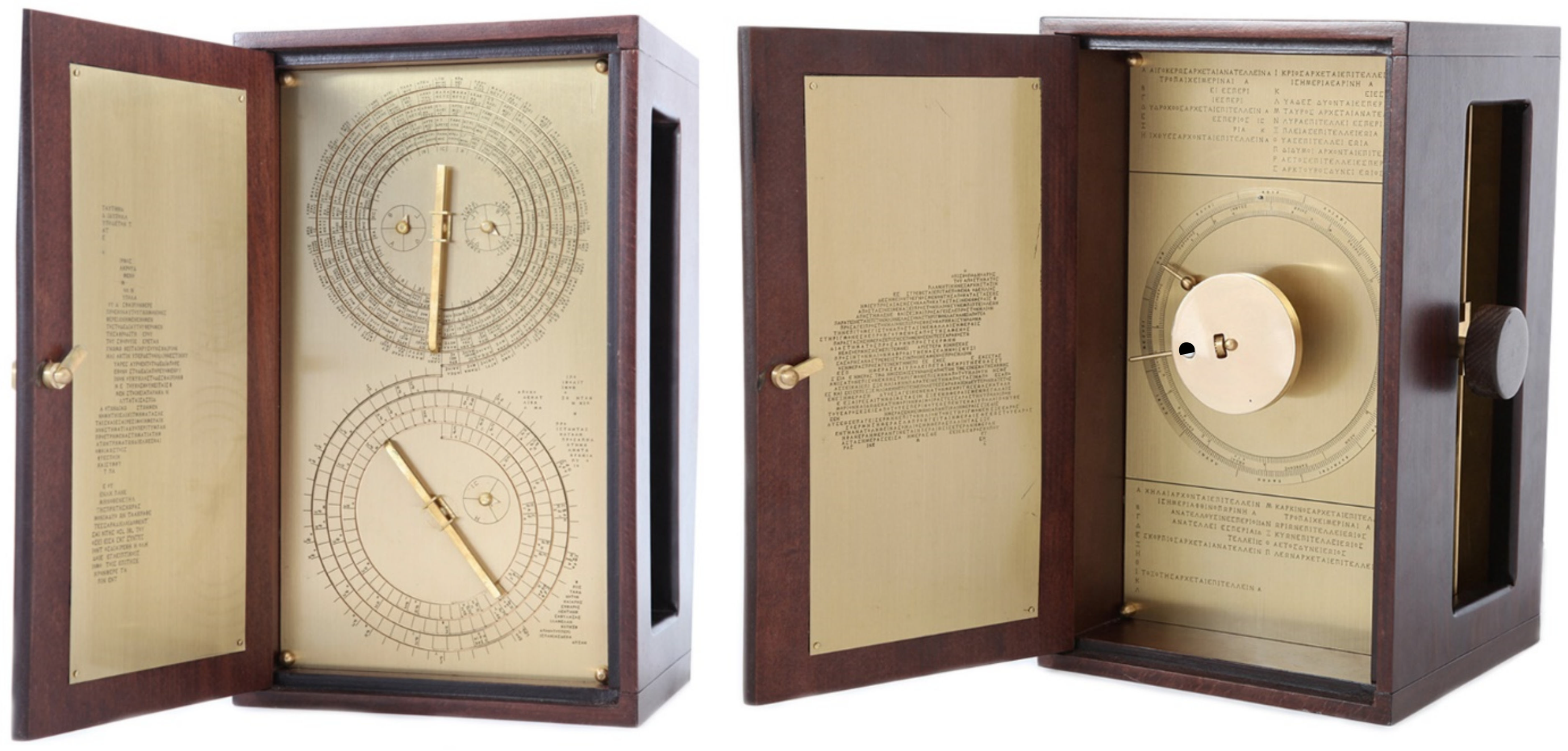

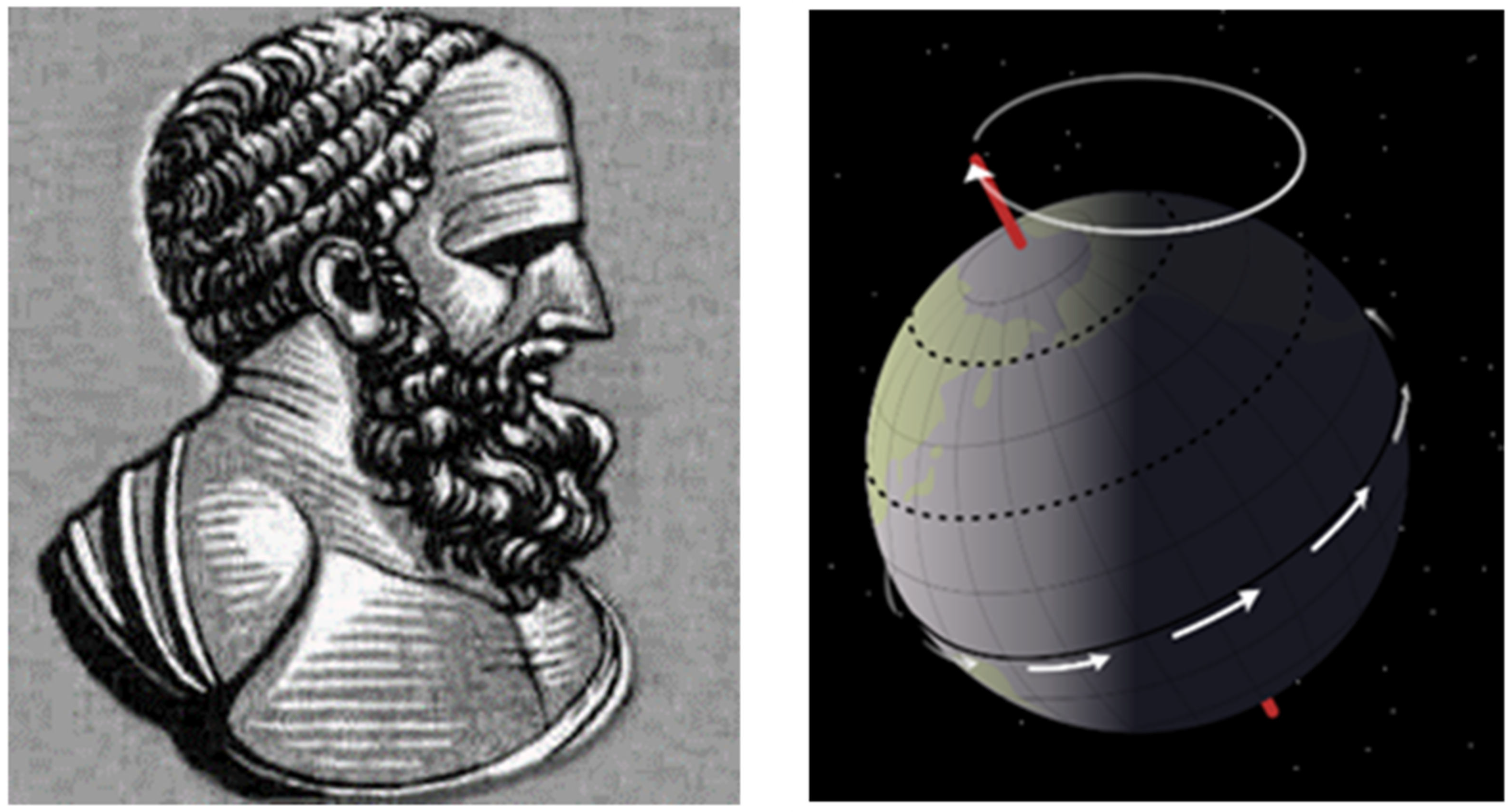






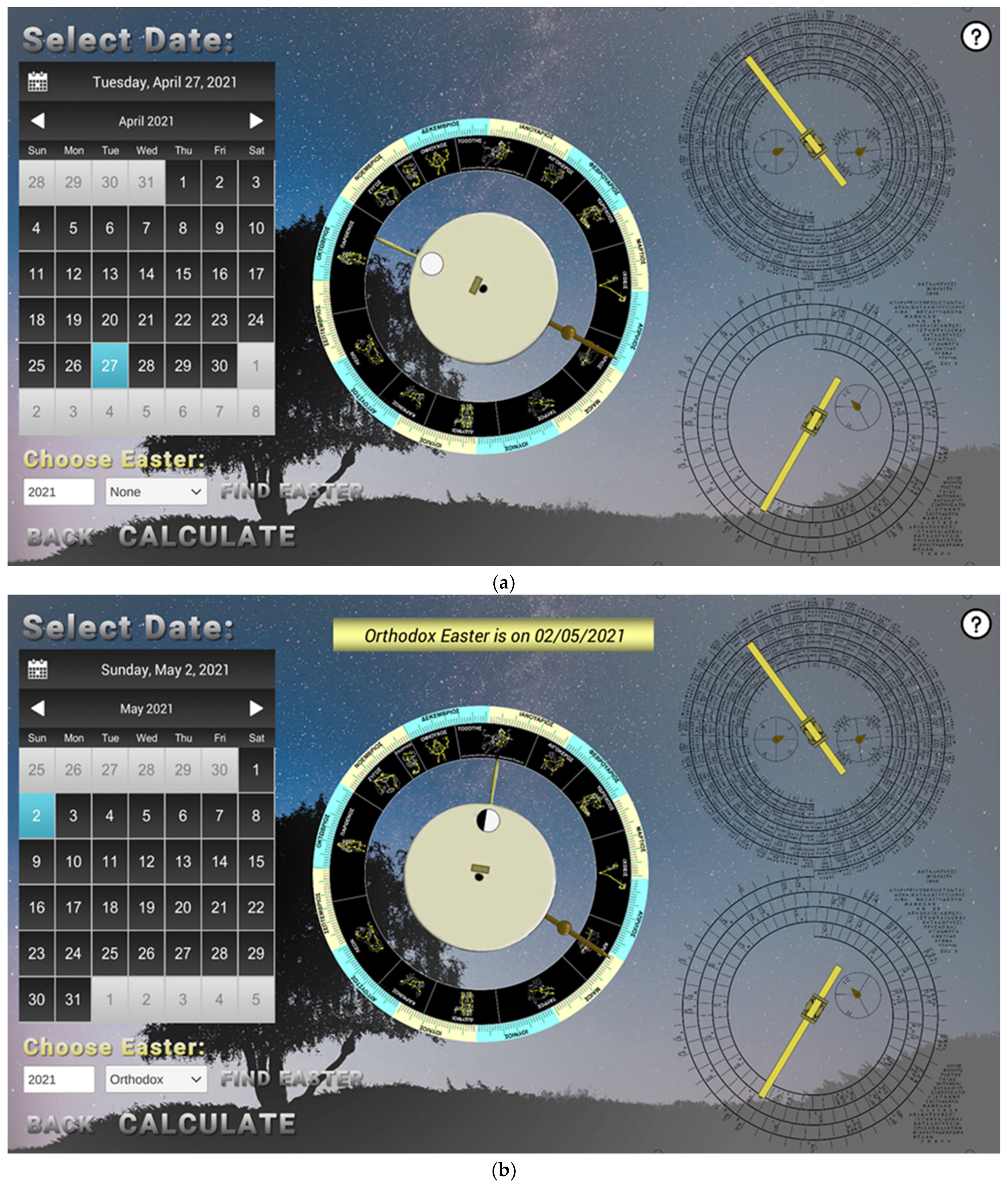





| Egyptian Months | |
|---|---|
| ΘΩΘ | Thoth |
| ΦAΩΦΙ | Phaophi |
| AΘΥΡ | Athyr |
| ΧOΪAΚΙ | Choiak |
| ΤΥΒΙ | Tybi |
| ΜΕΧΙΡ | Mechir |
| ΦAΜΕΝΩΘ | Phamenoth |
| ΦAΡΜOΥΘΙ | Pharmuthi |
| ΠAΧΩΝΣ | Pachons |
| ΠAΫΝΙ | Payni |
| ΕΠΙΦΙ | Epiphi |
| ΜΕΣOΡH | Mesore |
| +5 induced (epagomenal) days. | |
| Date | Position (Constellation) | Astronomical Phenomena | NASA Predictions(NASA SKYCAL Sky Events Calendar) | ||||
|---|---|---|---|---|---|---|---|
| Sun | Moon | New Moon | Full Moon | Sun Eclipse | Moon Eclipse | ||
| 12 October 1977 | Virgo | Virgo |  |  |  |  | Solar Eclipse on 12 October 1977 |
| 19 August 2001 | Leo | Leo |  |  |  |  | New Moon on 19 August 2001 |
| 11 October 2007 | Virgo | Virgo |  |  |  |  | New Moon on 11 October 2007 |
| 29 December 2035 | Sagittarius | Sagittarius |  |  |  |  | New Moon on 29 December 2035 |
| 17 January 2056 | Sagittarius | Sagittarius |  |  |  |  | Solar Eclipse on 31 January 1999 |
| 8 February 1982 | Capricorn | Leo |  |  |  |  | Full Moon on 8 February 1982 |
| 31 January 1999 | Capricorn | Cancer |  |  |  |  | Moon Eclipse on 31 January 1999 |
| 26 May 2021 | Taurus | Libra |  |  |  |  | Moon Eclipse on 26 May 2021 |
| 5 May 2023 | Aries | Libra |  |  |  |  | Moon Eclipse on 5 May 2023 |
| 11 August 2071 | Cancer | Capricorn |  |  |  |  | Full Moon on 11 August 2071 |
| Year | Antikythera Mechanism Application | https://en.wikipedia.org/wiki/List_of_dates_for_Easter | ||
|---|---|---|---|---|
| Date of Celebration the Catholic Easter | Date of Celebration the Orthodox Easter | Date of Celebration the Catholic Easter | Celebration the Orthodox Easter | |
| 2004 | April 11 | April 11 | ||
| 2009 | April 12 | April 19 | April 12 | April 19 |
| 2015 | April 5 | April 12 | April 5 | April 12 |
| 2020 | April 12 | April 19 | April 12 | April 19 |
| 2021 | April 4 | May 2 | April 4 | May 2 |
| 2022 | April 17 | April 24 | April 17 | April 24 |
| 2025 | April 20 | April 20 | ||
| 2032 | March 28 | May 2 | March 28 | May 2 |
| 2044 | April 17 | April 24 | April 17 | April 24 |
Publisher’s Note: MDPI stays neutral with regard to jurisdictional claims in published maps and institutional affiliations. |
© 2021 by the authors. Licensee MDPI, Basel, Switzerland. This article is an open access article distributed under the terms and conditions of the Creative Commons Attribution (CC BY) license (https://creativecommons.org/licenses/by/4.0/).
Share and Cite
Efstathiou, K.; Efstathiou, M.; Basiakoulis, A.; Kokkinos, N. The Antikythera Mechanism: The Prove of the Accuracy of the Astronomical Calculations Based on It. Heritage 2021, 4, 3848-3878. https://doi.org/10.3390/heritage4040211
Efstathiou K, Efstathiou M, Basiakoulis A, Kokkinos N. The Antikythera Mechanism: The Prove of the Accuracy of the Astronomical Calculations Based on It. Heritage. 2021; 4(4):3848-3878. https://doi.org/10.3390/heritage4040211
Chicago/Turabian StyleEfstathiou, Kyriakos, Marianna Efstathiou, Alexandros Basiakoulis, and Neofytos Kokkinos. 2021. "The Antikythera Mechanism: The Prove of the Accuracy of the Astronomical Calculations Based on It" Heritage 4, no. 4: 3848-3878. https://doi.org/10.3390/heritage4040211
APA StyleEfstathiou, K., Efstathiou, M., Basiakoulis, A., & Kokkinos, N. (2021). The Antikythera Mechanism: The Prove of the Accuracy of the Astronomical Calculations Based on It. Heritage, 4(4), 3848-3878. https://doi.org/10.3390/heritage4040211





